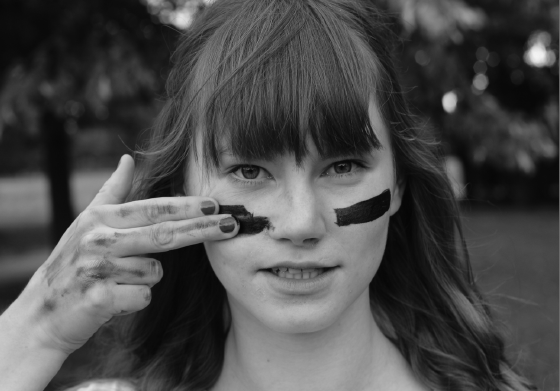What do physical societal standards say about us?

Alexandra Shafran
TRAINING FIERCELY. Smearing war paint on her face, Nikol Safronova ’17 doesn’t let her petite build keep her from lifting weights or tossing around a football. Despite the notion that certain physical appearances define what one can and can not do, many students choose to break from traditional boundaries and explore activities outside of their build.
Whether it’s posters of bodybuilders in the gym or photographs of a Chicago Ballet company, representations of physical stereotypes permeate our lives, clouding our heads with the rights and wrongs that we see, of what we are supposed to look like as men and women.
As children, a simple trip to the toy store could even enforce these norms onto us. The rows of dainty Barbie dolls, with fashionable clothes and a model figure, create the image of what a girl is encouraged to look like. The aisle for the boys, filled with buff action figures and superheroes, might lead young boys to think that they have to be muscular.
Some toy companies like American Girl Doll, base their mission around creating a diverse product that appeals and shares features of the owner of the doll, unlike most other doll companies who revolve all their products around one popularized image. An American Girl Doll representative said that when buying an American Girl doll, consumers can create and personalize their doll’s skin color, hair color and other physical characteristics.
But, at what point does one stop conforming ourselves to societal definitions of beauty? Throughout our careers, education and even hobbies, stereotypes of what we are ‘supposed to be’ might have clouded our judgment, as they have for Andrew Scheidler ’13, a sophomore dance major at University of Illinois. Scheidler experienced hesitation for many years as to whether or not he should pursue dancing. His perception of dance was that it was dominated by females who have been dancing since a very young age and who have incredible amounts of experience along with different physical capabilities due to increased flexibility, fluidity and musicality.
“The fear of having little to no experience and being thrown into something that I had little confidence in really acted as a barrier to my involvement in dance,” Scheidler said.
After much contemplation, Scheidler took the leap of faith and decided to join the dance community at Stevenson his senior year. He attended every master class offered through the Stevenson’s dance program and any studios nearby. Scheidler had a difficult time overcoming the predetermined stereotype that men don’t succeed in the art of dance.
Another activity stereotyped to have a predominant female community is yoga. But with an increasing popularity of the sport, more males are signing up for yoga classes according to Tabatha Whitney, owner of CraVe Yoga LLC, who has instructed yoga classes to more built and muscular male students.
“Most men, when they come into my studio, feel like they are engaging in something very feminine and that it won’t be challenging for them,” Whitney said. “Throughout the class though, you see their attitude completely change. They start to realize that no matter who you are—male, female, tiny or beefy—it’s very difficult to do.”
Scheidler mentioned that just because a certain stereotype exists for what you look like or how your physical makeup affects what you do, doesn’t mean that you should change yourself to fit into a pre-made mold. This applies for anything from sports to hobbies, or even everyday activities, he mentioned.
“If you are worried that your body will be a limiting factor, it won’t. Art can take many shapes or forms, but it does not have to fit the stereotype of what art is,” Scheidler said. “In terms of dance, if that means deviating from a high kick because you have physical limitations, it only means that your choreography will be all the more original.”

